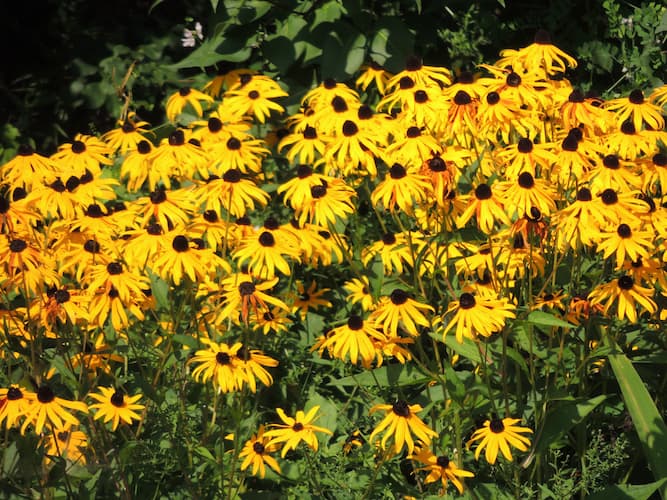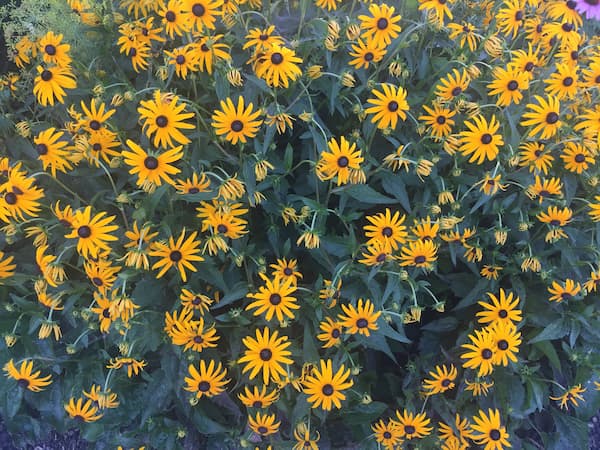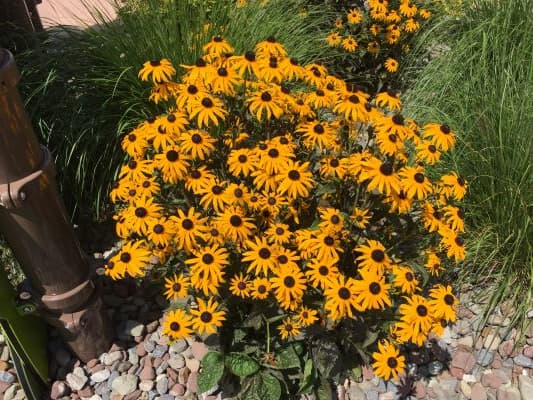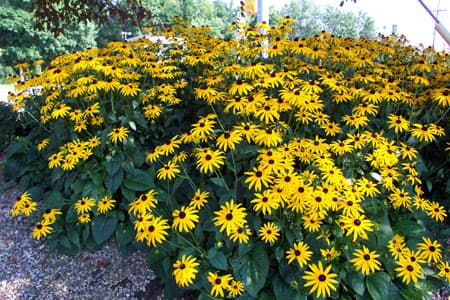How to Grow Black-Eyed Susan Flowers

Native to North America, Black-Eyed Susan plants are prolific wildflowers that have become popular in the home flower garden. They are bush habit plants, separate and distinct from Black-Eyed Susan Vines. Also called Gloriosa Daisy, flower colors include yellow, orange, and gold colors with a dark brown center. While the plants are beautiful when in bloom their medium green leaves are roughly textured and scratchy. Growing Black-Eyed Susan Flowers are very easy, requiring little attention to produce plentiful and colorful blooms.
Almost everyone knows this American wildflower. It has a lovely, warm color, daisy shape, easy to grow in any sunny place. established plants need little attention. Pollinators love the. It is fun to watch bees and butterflies as the flitter from flower to flower in search of the nectar.
Grow Black-Eyed Susan in masses in flower gardens, or broadcast spread seeds as wildflower.
Black-Eyed Susans are great cut for bouquets or vases. The cut flowers are long-lasting.
Black-Eyed Susan Plant Specifications
Flower Colors: Yellow, orange, and gold colors with a dark brown center.
Flowers Bloom: Early Summer through Fall.
Plant Height: 24 to 36 inches tall.
Light Requirements: Full sun to partial sun.
Ideal Soil pH: 6.0 – 7.7.
Hardiness Zone: 3 – 9. This versatile plant grows well in most hardiness zones.
Toxicity: Black-Eyed Susan plants are edible. But, they are poisonous if consumed in large quantities.
Native To: Northern America.
Plant Type: Perennial
Botanical Name: Rudbeckia Hirta
Number of Species: 25
Other Names / Notable Varieties: Brown-Eyed Susan, Gloriosa Daisy
Are Black Eyed Susan Plants Edible?
While Black-Eyed Susan are edible, they are usually only consumed for medicinal purposes. They have an unpleasant, bitter taste.
The plant is poisonous if consumed in large quantities. It can cause allergies and gastr0-intestinal ailments.
Black-Eyed Susan Medicinal Uses
Native Americans used Black Eyed Susan plants for treatment of a variety of ailments.
Among the traditional uses are:
- Cold relief treatment.
- Relieve urinary tract infections.
- Treating snakebites.
- Use the plant’s roots to treat parasitic worms.

Perennial Black-Eyed Susan Flower Propagation
These plants are grown from seed. They are good re-seeders and also spread through their roots. So, select a planting site where they can grow undisturbed for many years. If started early in the spring, you may get blooms the first year. The seeds can be directly seeded into your flower garden as soon as the soil can be worked in the spring or later in the summer or fall for flowers next year.
You can also start plants indoors, 8-10 weeks before the last frost date for your area. As planting time nears, harden off the young plants for several days.
Important: Black-Eyed Susan seeds need light to germinate. Plant very shallow.
The plants grow 2-3 feet tall. Flowers bloom atop long stems. If grown in flower gardens, space 1 to 1/12 feet apart.
Days to Germinate: 10 – 20
Keep the soil moist for your young plants to help them to establish and grow. Mature plants are drought resistant.
The plants can also be propagated, division. Dig up plants, separate them into clumps, and re-plant the clumps. If you have extra, don’t toss them. Rather, give a few clumps to your gardening friends. Or, plant them in a naturalized setting in a field.

How to Grow Perennial Black-Eyed Susan Flowers

These short-lived perennials are very easy to grow. The plants like full sun. They will do well in average soils and even poor soils. They also tolerate dry soil conditions. While you do not need to water or fertilize established Black-Eyed Susan plants, a little extra love and care will be rewarded with more blooms.
Spread a layer of mulch around the plants. This creates a neat and attractive appearance and helps to retain soil moisture. We recommend compost mulch which will feed the plants as it decomposes.
Keep plants well weeded when young. Established will grow in thick clumps, and usually will not need weeding. The plants will tolerate a little crowding and look their best in groups.
Once your plants are established, they will grow well unattended for many years.
Separate the clumps after a few years, or the plants will crowd each other out, resulting in smaller plants and flowers.
Garden Tip: Deadhead spent blooms, to prolong the blooming period.
Also see: Plant Problems – causes and cures
Insects and Plant Disease
Black-Eyed Susan is resistant to insects and disease. Fungal disease can form dark leaf spots on the plants in humid weather. Thinning the plants to provide good air circulation round them helps to avoid this problem.
If insect or disease problems occur, treat early with organic or chemical insect repellents and fungicide.
Also see: Plant Problems – causes and cures.
Related Articles
People who read this article also like:
Black Eyed Susan Vines – Thunbergia Alata
How to Grow Rudbeckia Hirta Plants – by Garden Hobbies
Please support our site. Shop for:
- rmmatthews100@hotmail.com
- 585-721-6528
- Rochester, NY
©1999-2024 GardenersNet.Com, All Rights Reserved

